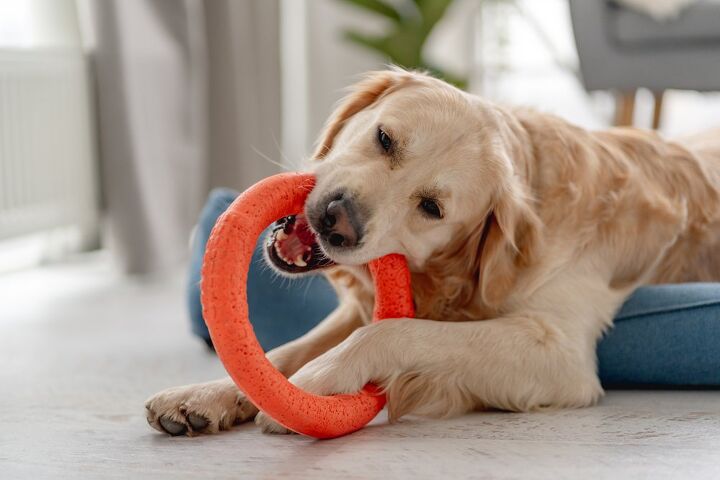How To Prevent Your Dog From Chewing On The Walls

There is a lot that goes into training and caring for a dog. You need to feed the dog and give it water, of course. Then you need to tend to its bathroom needs, which means letting it outside and taking it on walks. This is just the tip of the iceberg, as you also need to make sure the dog is stimulated and well-trained, so it does not wreak havoc on your home. If left to its own devices, a dog can ruin carpets, and shoe collections, and even chew on the walls. If you notice your dog has started to chew on the walls, you are going to want to change this behavior immediately.
To prevent your dog from chewing on the walls you need to understand why it is chewing on the walls in the first place. Reasons include anxiety, boredom, lack of stimulation, and teething. To stop this behavior, get good chew toys and long-lasting treats. Take the dog on walks, and stimulate it with games and puzzles. Don’t forget to properly dog-proof your home, and consult a veterinarian if the problem persists.
There are all sorts of reasons why your pup has decided to start chewing on the walls. The good news, is that there are just as many ways to prevent your dog from doing it. But before you can find the solution to this problem, you first need to understand the potential reasons why your dog has decided to chew on the walls in the first place.
Potential Reasons Why Your Dog Is Chewing On The Walls
The Dog Has Anxiety
One reason for a dog to chew on a surface that it shouldn’t be, is anxiety. Dogs have a range of emotions, which is why they are such great companions. But these emotions are not always joyful. Sometimes a dog, for one reason or another, can exhibit nervous and anxious behavior. Anxiety can even manifest itself in the form of compulsive chewing. If your dog’s chewing seems compulsive and anxious and doesn’t improve over time, you may want to consider reaching out to a veterinarian for advice on how to help your dog’s anxiety.
Your Pup Is Teething
If you have a puppy who is chewing on everything, you might be overwhelmed. The good news, is this is likely a brief phase. Puppies often chew on walls and anything else they can get their teeth into when they are teething. They find it soothing and it helps facilitate the teething process, even if it hurts the walls.
Pure Boredom
Another reason a dog chews on walls is simply out of boredom. Just as humans chew gum or snack on potato chips out of boredom, dogs also like to chew when bored. If you find your dog only chews on the walls when it is left alone with nothing to do for hours at a time, the cause may be boredom.
A Lack Of Stimulation
Similar to boredom, if a dog is not given space to roam, or puzzles to stimulate its brain, it might start chewing on the walls. A lack of physical and mental stimulation can lead a dog to chew on walls, act out, and take out its energy in other undesirable ways.
There Is Too Much Temptation
Another reason your dog could be chewing on the walls is due to an overwhelming amount of temptation. If you don’t dog-proof your home, and your dog can roam free and cause damage throughout the home before it is properly trained, then there is a good chance it will chew on walls, furniture, and other things it shouldn’t.
Eight Ways To Prevent Your Dog From Chewing On The Walls
1. Understand What Is Prompting The Behavior
First and foremost, you need to spend time understanding why your dog is exhibiting this undesirable behavior. The most important way to get your dog to stop chewing on walls is to identify the cause or causes associated with the chewing. Once you can narrow it down to one or two potential reasons, try the remaining remedies listed below.
2. Get Your Dog Some Toys
If your dog is chewing on the walls due to boredom, teething or lack of oral stimulation, then some new toys might be in order. Most dogs love toys, especially dogs that are fond of chewing. Just remember that some toys are better than others when it comes to chewing. Find toys that will last a while, and perhaps ones that squeak and have a few different textures. Dogs tend to react to these types of toys favorably — and prefer them to chewing on walls (usually).
3. Purchase Long-Lasting Treats
If your dog isn’t a giant chew toy fan, you can also buy long-lasting treats. There are meat-jerky type toys, pigs ears, and yak cheese. Most dogs go crazy for these treats, and they provide endless chewing entertainment. Best of all, it keeps their teeth off your walls.
4. Give Your Dog More Exercise
One potential reason your dog is chewing on the walls is a lack of exercise. A dog that is stuck at home all day is bound to get restless and scratch window screens or chew on things it shouldn’t. This restless behavior and bottled-up energy can result in your dog chewing on walls.
Don’t let your dog bottle up extra energy. Help your pet get all that energy out. Take your pooch on long walks, or find a nearby dog park where it can run around and play with other dogs. If your dog is a fan of fetch, play fetch in a big field where it can get all its energy out.
5. Mentally Stimulate The Dog
Mental stimulation is also important. A lack of mental stimulation can frustrate a dog as much as being cooped up all day. This is especially true when it comes to very intelligent breeds. So play games and puzzles and invest time in training your dog consistently. This should help prevent your dog from chewing on walls.
6. Limit Access To Temptation
Regardless of why your pet is chewing on the walls, it is always a good idea to limit its access to areas where it is causing trouble. This means putting effort into dog-proofing your home. Use gates or barriers when needed to keep your dog out of rooms where it tends to chew on surfaces. This is also a great way to help train your dog and prevent it from getting into unnecessary trouble.
7. Use Chew Deterrent Sprays
If your dog seems to prefer chewing on walls more than toys, and no other method seems to work, then use a chew deterrent spray. There are several sprays, including a sour apple spray, that are harmless and non-toxic, but make surfaces very bitter.
If you spray this substance on any area your dog likes to chew, it will find the flavor very unpleasant, and there is a good chance it will stop chewing in this area. Make sure you don’t use sprays that are toxic for your dog.
8. Consult A Professional If The Problem Persists
If you have tried everything, including giving your dog toys, exercise, and training, then you might need to seek professional help. This is especially true if you are not the dog’s first owner. Your dog might have some anxiety or other issues that a vet can help you with. It may also just need some advanced training that you don’t currently have the tools to implement. Either way, some professional advice can be quite helpful if this problem is affecting your home in a major way.
Summing Up How To Prevent A Dog From Chewing On Walls
Dogs are a bundle of joy, but they can also be quite a handful to take care of. If you notice that your dog is chewing on the walls, you will want to find ways to prevent this immediately. The first step is to identify why your pooch is choosing to chew on walls. Reasons can include a lack of activity or stimulation, boredom, teething, or even anxiety.
Try buying your dog some good chew toys or long-lasting dog treats. Make sure your dog gets plenty of exercise and stimulation, and dog-proof your home to minimize the potential for wall chewing.
Related Guides:

Tom Gaffey is an expert writer who currently resides in Washington D.C. Tom has a passion for real estate and home improvement writing, as well as travel and lifestyle writing. He lived the last twelve years in Hawaii where he worked closely with luxury resorts and event planners, mastering his knowledge of aesthetics and luxury products. This is where he found his passion for home improvement and a keen interest in DIY projects. Currently, Tom resides in Washington D.C, and also working on his debut fiction novel.
More by Tom Gaffey



























